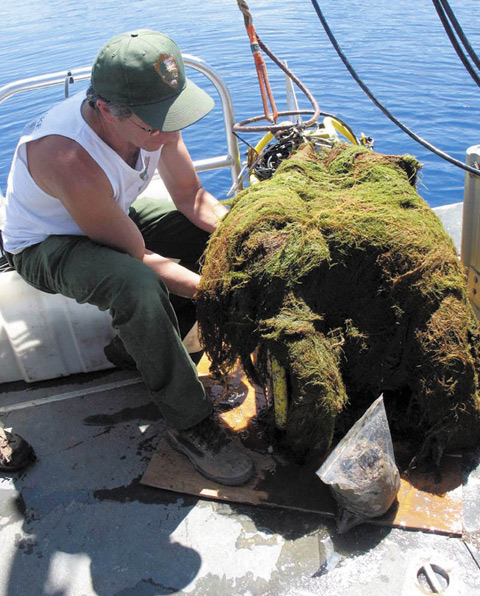Unraveling the secret of Crater Lake’s … Deep Moss
Mail Tribune
Medford, Oregon
April 2, 2007
By JOHN DARLING

An organic colony living between 100 and 420 feet down may hold clues to the lake’s past and signal changes in its future
Mark Buktenica, aquatic ecologist and resource manager at Crater Lake, looks over a moss sample taken from the lake. (Photo courtesy Steve Jessup)
It’s huge, it’s deep in the waters of Crater Lake, it’s older than Methuselah — and it’s alive.
The good news is: It won’t bite you.
It’s a huge colony of moss that has lived quietly in the depths of the clearest lake in the United States since somewhere between 4,000 and 7,700 years ago after Mount Mazama blew its top and created the hole that Crater Lake would fill.
Since the oldest redwood is 2,200 years old and the oldest bristlecone pine is 4,770 years old, is this moss bed the oldest living thing?
“That myth is out there and I can’t stop it, but there’s no way of saying that, because it’s not one organism,” said oceanographer Bob Collier of Oregon State University. He’s a member of the scientific team that studied the organism with a submersible ROV (remotely operated vehicle) last summer and plans extensive exploration with scuba gear this summer.
At the bottom (the oldest part) of the mat, I believe it’s thousands of years old — five, six, seven thousand, we don’t know, but I do not encourage the single organism view any more than you’d say a forest is a single organism,” he said.
Biologist Steve Jessup of Southern Oregon University, also on the scientific team, said, “the whole system is very mysterious and we’re just starting to get into it, but no, you can’t count it as one living thing. It’s a complex ecosystem up to 4,000 years old, maybe more.” Scientists are fascinated with the behemoth of the plant kingdom, called “Deep Moss,” because it seems to be growing very slowly over a very long period in a very nutrient-poor environment, but doing very well at it.
The community of moss, mostly of one species — Drepanocladus, is “live, verdant stuff,” 3 to 6 feet thick (sometimes up to 20 feet), living chiefly between 100 and 420 feet deep, says Mark Buktenica, aquatic ecologist and resource manager at Crater Lake. Most of it thrives on the shelf around Wizard Island and some on the more vertical walls of the caldera.
To help determine its age, as well as the biological history of Crater Lake and its region, scientists will dive this summer, taking core samples of the moss, which is laid down in layers, with the oldest on the bottom, like soil sediment, said Jessup.
“It’s important because the sediment profile has information. Organisms settle out. There will be ash layers. Different pollen (in the various layers) will tell us what was growing at every age in Crater Lake’s history. We’ll learn a lot about the climate and geology,” said Jessup.
The pollen will be carbon-dated, making the moss serve the function, after a fashion, of tree rings for Crater Lake.
The layers at the bottom of Deep Moss, examined by the unmanned ROV, appear brown and dead, but Jessup brought some back to SOU and, after cultivating them in aquariums, saw them green up and jump to life.
Deep Moss could also be called Big Moss. Jessup cautions against calling it the biggest living thing but does say its mass is 10 grams to the 11th power. How big is that? A lot, he jokes. Enough to crush your house and more.
Another big mystery of Deep Moss is that it’s full of holes.
“I’ve never seen anything like it,” says Jessup. It could be hot springs that have bubbled up through it in the past, avalanches or hunks of ice that fell on it or anaerobic (without oxygen) decomposition, that takes place very slowly, he adds.
Deep Moss was discovered in 1988 during exploration of Crater Lake’s 1,996-foot depths, with funding from National Geographic — and is only now being intensely investigated.
Scientists have created several models of how the moss works in the lake ecology, Jessup says, including that it may act as a kind of stomach for Crater Lake, slurping up a “lake snow” of dead diatoms, phytoplankton, tiny shellfish and worms that drift to the bottom.
The moss beds help monitor the planet’s health and the effects of global warming, says Collier. If the pristine water, the clearest in the U.S., became compromised, scientists believe the moss would begin growing at shallower levels, to get at light.
After comparing growth levels with 20 years ago, they’ve found the moss has stayed where it was — and the lake is as clear as ever.
John Darling is a freelance writer living in Ashland. E-mail him at jdarling@jeffnet.org.
Other pages in this section

